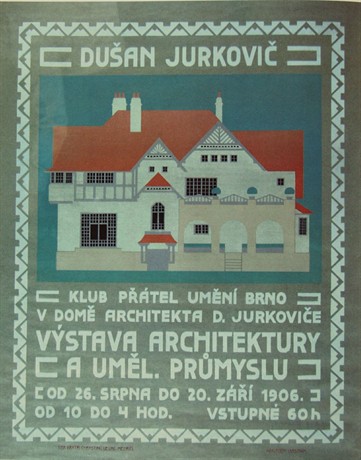Dušan Jurkovič
The architect Dušan Samo Jurkovič was born on 23 August, 1868 in thevillageofTurá Lúka, westernSlovakia. He went to grammar school in Šoproň (now part ofHungary) and then enrolled at theStateTechnicalSchool, Vienna. In 1889 he joined the studio of the architect Michal Urbánek in Vsetín. Travelling toPraguewith Urbánek for the National Jubilee Exhibition in 1891, he sawTheCzech Cottage, anarchitectural collage. In the following year, Urbánek and Jurkovič organised an ethnographic show in Vsetín at which Jurkovič presented an installation he calledTheWallachianRoom. Three years later, both architects made the most of their meticulous study of folk architecture in theWallachianVillageproject at the Czechoslovak Ethnographic Exhibition inPrague, where Jurkovič also presented hisČičmanyFarmhouse. Success at the Prague exhibition brought the young architect his first independent commissions, among them the design of a series of tourist buildings in Pustevny (1897-1899). Widening recognition of the quality of his Maměnka hostel and the Libušín diner, parts of the Pustevny complex, enabled Jurkovič to launch his own career. Its beginnings were associated withBrnoand with František Mareš, Headmaster of theVesnaSchoolfor Girls, for which Jurkovič designed the interiors.Brnofactory owner Robert Bartelmus commissioned Jurkovič to design a country house made of wood in Rezek, near Nové Město nad Metují, at the turn of the century. Its design introduced the concept of the "British cottage" into the architect's oeuvre, as well as to Czech architecture. Apart from a number of public and private buildings forBrnoclients, in the early 20th century Jurkovič was responsible for the reconstruction of spa buildings in Luhačovice, among his most important work. Although his original plans for a large-scale Slavic centre never materialised, several remarkable buildings emerged in Luhačovice in 1901-1903. Jurkovič's original development of folk principles may be considered at its zenith in the designs of the Jan (now Jurkovič) House, the Cottage and the Sun Baths.
Strong ties with folk art did not stop Dušan Jurkovič designing highly modern buildings, interiors and furniture. Jurkovič transcribed British trends of the period into the inhalatorium building in Luhačovice (1903). The courtyard of a community house in Skalice (1905) with a strip of windows below the truss brings British architecture to mind; at the same time, it indicates Jurkovič's knowledge of contemporaneous Japanese architecture. The artist's villa in Brno-Žabovřesky (1906) became an embodiment of change in Jurkovič's approach to folk art as it grew looser and more creative, with a distinct inclination towards geometrics and abstraction. Jurkovič drew inspiration in the design of his house from Olbrich's villas in an artists' colony in Darmstadt (1900-1901) and from Hoffmann's buildings at Hohe Warte, near Vienna (1900-1901). The house designed by Joseph Olbrich for his brother Edmund in Opava (1904) led Jurkovič to the dramatic elevated gable of the Jan and Luisa Náhlovský villa in Prague-Bubeneč (1907). He also employed an elevated gable on the frontage of a residential block of flats for glassmaking factory owner Benedikt Škarda in today's Dvořákova Street, Brno (1908). His modification of a chateau for entrepreneur and garden centre owner Jaroslav Veselý in Molitorov, near Kouřim (1908-1911) oscillates between vernacular architecture and abstract modernism. Between 1908 and 1913 Jurkovič occupied himself with the reconstruction of the Nové Město nad Metují chateau for Josef Bartoň, a textile manufacturer from Dobenín. Most of the exterior was restored, while the garden, with its original bridge, was landscaped from scratch.
Jurkovič spent much of the war in Galicia, Poland (1916-1918), where he directed the construction of cemeteries for the fallen. The artist employed his experience from Hostýn Hill (1903-1913), the Stations of the Cross chapels of which resonate with the surrounding landscape. He composed his cemeteries in sympathy with the countryside, in monumental forms, merging timeless shapes with folk ornament. Jurkovič's designs for the Galician cemeteries anticipated one of his masterpieces of the genre, the Milan Rastislav Štefánik Memorial on Bradlo Hill. Jurkovič, always a staunch supporter of the new state, had known Štefánik since childhood, and was quick to consider the construction of a spectacular memorial. He chose Bradlo, a hill commanding the rolling Myjavsko countryside, as the site. The memorial was formally unveiled on 23 September 1928.
Upon he establishment of Czechoslovakia as an independent state on 28 October, 1918 Jurkovič felt that he should return to Slovakia, his homeland, and help shape a new Slovak culture. He sold his Brno house in 1919 and moved to Bratislava, the Slovak capital, where he built himself a villa. It is part of a small estate that Jurkovič designed for his friends. By the later 1920's, Jurkovič was clearly inclining towards functionalism. The Koch Sanatorium, Bratislava is a fine example. Jurkovič also designed houses for working people. During his stay in Brno he had already produced designs for estates for house workers in Hronov (1907) and Nový Lískovec (1909), the latter actually realized. In the post-1919 phase, he designed, for example, the Hohenaj estate near Dynamitka, Bratislava, and houses assembled from wooden sections and prefabricated brickwork parts. In addition, he contributed to the technology of the times with designs such as the stations of a cable-lift to Lomnický Štít, projects that went on to become art icons of their time (1936-1937). The architect also dedicated himself to heritage care, and occasionally worked in Moravia and Bohemia. He participated in the Exhibition of Contemporary Culture in Brno (1928) and designed a weekend house for Vojtěch Houdek in Ostravice (1927). Petr Bezruč, a famous Czech poet, had his cabin in Ostravice equipped with furniture designed by Jurkovič (1935). During the Second World War, the architect lived in seclusion, designing memorials and an annexe for the Molitorov chateau (1942, unexecuted). After the war he involved himself once more in the renewal of the country. Dušan Jurkovič, a lifelong optimist with a deep faith in Czechoslovakia as a nation, died in Bratislava on 21 December, 1947.

